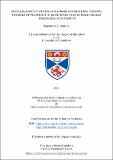Files in this item
Social plasticity within and across generations : testing the role of plasticity in rapid evolution in field cricket Teleogryllus oceanicus
Item metadata
| dc.contributor.advisor | Bailey, Nathan W. | |
| dc.contributor.author | Sturiale, Samantha Leigh | |
| dc.coverage.spatial | [5], 73 p. | en_US |
| dc.date.accessioned | 2022-05-18T11:52:36Z | |
| dc.date.available | 2022-05-18T11:52:36Z | |
| dc.date.issued | 2021-06-30 | |
| dc.identifier.uri | https://hdl.handle.net/10023/25401 | |
| dc.description.abstract | The field of evolutionary biology lacks a full understanding of how phenotypic plasticity influences adaptive evolution, despite over a century of research effort. One under-studied question within this topic is whether plastic responses occurring within the lifetime of an individual (within-generational plasticity or WGP) versus across generations (transgenerational plasticity or TGP) produce different evolutionary outcomes. To understand how these two forms of plasticity interact, I investigated to what extent an individual’s phenotype is shaped by its own social environment and the social environment experienced by its mother using a field cricket model, Teleogryllus oceanicus. Crickets in the Hawaiian Islands are targeted by acoustically orienting parasitoid flies, and a mutant form of silent male (‘flatwing’) recently invaded and rapidly spread under this pressure. Some populations have undergone a full shift from all normal, singing males to all flatwing, silent males, dramatically changing the social environment, and providing the opportunity to explore the hypothesis that both WGP and TGP play a role in adaptive evolution following abrupt environmental change. First, I explored what variation exists in the juvenile morphology and behavior of individuals carrying normal-wing vs. flatwing genotypes, prior to maternal social manipulation. At multiple juvenile stages, flatwing-carrying individuals exhibit greater locomotive activity than normalwing individuals, suggesting a co-evolved genetic response or the prior genetic coupling of locomotor activity with flatwing variants. Second, I tested consequences of social plasticity for the fitness traits of reproductive investment and mating behavior in adult females carrying the flatwing genotype, which might permit them to adjust to the absence of song in their environment. This demonstrated that females homozygous for flatwing raised in silence exhibit reduced body condition and reproductive investment compared to those raised in song, as predicted. Mating behavior, in contrast, was not sensitive to social environment in these females. Third, I tested whether maternal acoustic environment affects juvenile offspring behavior and morphology, whether effects of maternal acoustic environment persist through offspring development into adulthood, and how the adult social environment of offspring interacts with transgenerational plasticity induced by their mothers’ social environment. Unexpectedly, adult, but not juvenile, offspring of mothers raised in different social environments exhibit differences in several ecologically relevant characteristics such as pronotum length, somatic condition, and reproductive investment. Taken together, these results illustrate that genetic and plastic responses may jointly influence the dynamics of rapid adaptive evolution. Further, when exploring the effects of plasticity in adaptive evolution, it is important to consider how WGP and TGP may act simultaneously, and in a non-additive nature, to influence an individual’s phenotype. | en_US |
| dc.language.iso | en | en_US |
| dc.rights | Creative Commons Attribution-NonCommercial-NoDerivatives 4.0 International | * |
| dc.rights.uri | http://creativecommons.org/licenses/by-nc-nd/4.0/ | * |
| dc.title | Social plasticity within and across generations : testing the role of plasticity in rapid evolution in field cricket Teleogryllus oceanicus | en_US |
| dc.type | Thesis | en_US |
| dc.type.qualificationlevel | Masters | en_US |
| dc.type.qualificationname | MSc (Res) Master of Science | en_US |
| dc.publisher.institution | The University of St Andrews | en_US |
| dc.identifier.doi | https://doi.org/10.17630/10023-25401 |
The following licence files are associated with this item:
This item appears in the following Collection(s)
Except where otherwise noted within the work, this item's licence for re-use is described as Creative Commons Attribution-NonCommercial-NoDerivatives 4.0 International
Items in the St Andrews Research Repository are protected by copyright, with all rights reserved, unless otherwise indicated.


